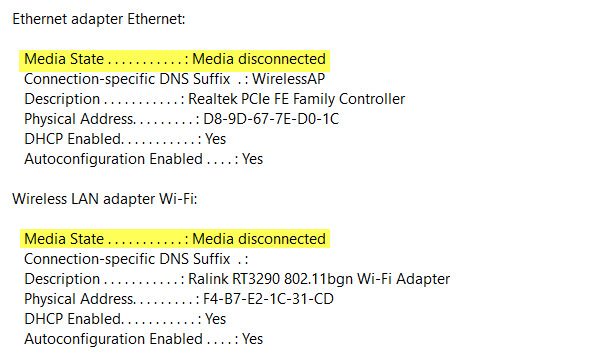A PC without an internet connection is pretty much useless these days, and if you are having problems getting connected to a network and can’t get onto the Internet, don’t panic. There are a few basic things you need to check before we actually troubleshoot. Make sure you have working internet, maybe try it with some other device, and secondly, make sure your PC is properly connected over cable or connected to the router over WiFi. If that’s working fine, it’s time to check out our guide on how to fix the Media State Media disconnected error message on Windows 11/10.
Open a command prompt with administrator privileges and execute the following command:
ipconfig /all
This will list all the connected media i.e. Ethernet and Wifi along with its status.
Look closely and see if you have an error which says:
Media State . . . . . Media disconnected

If that’s the case, we need to resolve issues with the internet, and the adapter on your PC.
In case none of your adapters are in the list, you first need to troubleshoot the problem with the wireless adapter.
1] Reset WINSOCK and IP Stack
You can open the command prompt with admin privileges by using Windows key + X and select Command Prompt (Admin) from the context menu.
In the command prompt, type the following commands:
netsh winsock reset catalog
This will Reset Winsock entries
netsh int ipv4 reset reset.log
This will reset IPv4 TCP/IP stack.
netsh int ipv6 reset reset.log
This will reset the IPv6 TCP/IP stack.
Once you have reset the TCP/IP stack and Windows Sockets API entries, reboot your machine for the changes to take effect.
2] Is your Network Adapter Disabled?
If you have disabled the network adapters on your PC, you will need to re-enable it as well.
Go to Settings > Network and Internet > Select Ethernet > Change adapter options > Right click on the adapter, and enable it.
3] Check WiFi Properties
This is rare, but if WiFi Sharing has caused issues, you need to go to Network Connections > Right-click WiFi > Properties > Sharing tab > Select the first one and press OK.
4] Update Drivers
Go to Device Manager > Network Adapters, and click on the down arrow and it should reveal both the Ethernet adapter and your wifi adapter. Check if any of them have a red x on them? Right-click on the one which has a red X and to choose Properties. Then click on the Driver tab to see which driver version it currently has. See if you can uninstall the driver, and reboot to let Windows find the driver for you. You can also download the driver from the OEM website and update the driver.
Let us know if anything here helped you.
Leave a Reply